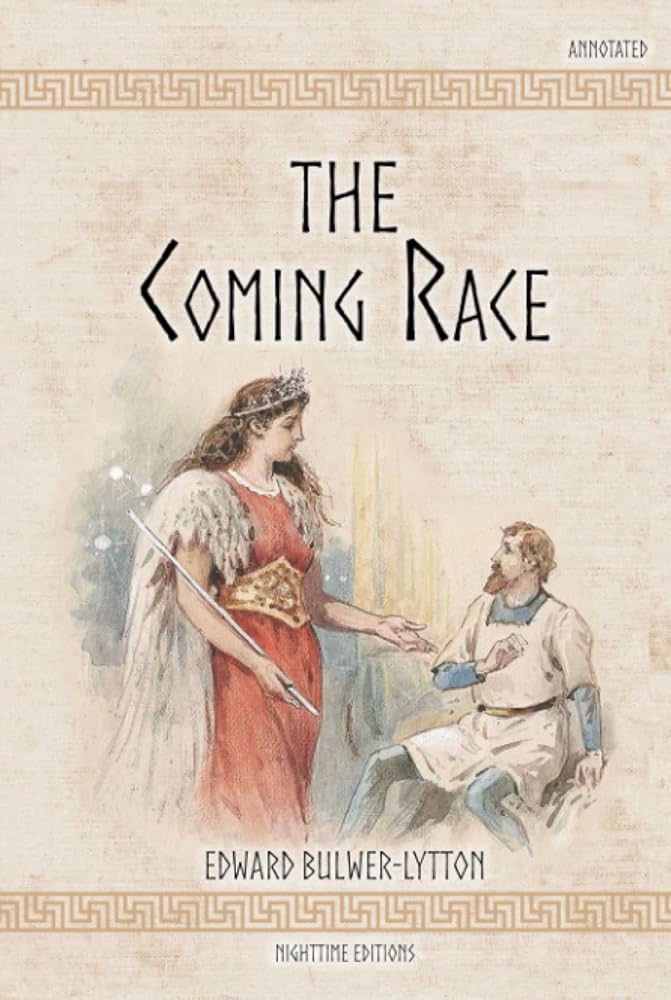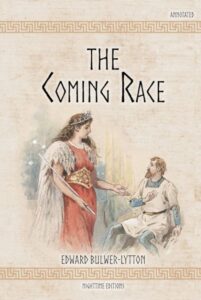Chapter I — The Coming Race
byChapter I opens with a personal recounting of heritage and identity, establishing the narrator’s background as rooted in early American history. He speaks of his English ancestry and notes how his family, having contributed to America’s founding struggles, eventually stepped away from public affairs after political disappointments. Born the eldest of three sons, he was expected to pursue knowledge and opportunity beyond his homeland. At sixteen, he traveled to England, where he embarked on a path of formal education and later began commercial training in Liverpool. Though destined for a conventional life, his father’s passing changed the course of his ambitions. Inheriting a modest fortune and emboldened by a thirst for the unfamiliar, he chose not to settle but to wander, crossing countries and oceans with a spirit shaped by both intellect and impulsiveness.
One particular journey in 18__ took him to a rugged, remote region where geological curiosities drew scholars and adventurers alike. He reunited with an old friend—an engineer of fine repute—who was investigating an abandoned mining site marked by stories of seismic activity. At first, their daily excursions into the mine seemed like standard explorations: long tunnels, dripping stone walls, and remnants of tools half-consumed by time. But deeper still, beneath layers of rock and sediment, they stumbled across something wholly unexpected—a vertical fissure that hinted at secrets buried far below the earth’s known layers. This chasm was no ordinary crack. Its walls bore signs of searing heat, as if blasted open by volcanic fire in some ancient cataclysm. The darkness it offered was not just physical but also intellectual. No map could chart it. No compass could guide a descent.
One morning, while the narrator observed from a ledge, his engineer companion decided to explore the rift. Lowered carefully into the abyss, he vanished from view, his lantern flickering until it too was consumed by blackness. When he returned, hours later, a change had overtaken him. His eyes darted more nervously, and he spoke with a hesitation that had not been there before. No longer was he eager to investigate or speculate. His mind appeared haunted, not by physical exhaustion, but by something he had seen. The narrator, concerned yet intrigued, offered him food, drink, and the comfort of companionship. Over brandy, the tension slowly broke, and the truth emerged—not in a single burst, but in fragments. What had been discovered below was not ruin but structure. Not chaos, but evidence of design.
The engineer described a tunnel so vast that it resembled a cathedral built from stone and light. It pulsed not with fire but with a steady illumination that could not be explained by known chemical or natural means. The walls were carved with precision. The road that stretched beneath him seemed to lead somewhere—not to emptiness, but toward purpose. Figures had been seen, distant yet unmistakably moving. Not shadows of animals, but upright, sentient forms. Their movements were too deliberate to be random, their presence too silent to be accidental. The narrator listened, at first skeptical, then entranced. The idea that a whole civilization could thrive unnoticed beneath the crust of the earth was both terrifying and thrilling.
Such a possibility unraveled the threads of everything he thought he knew. Geography, biology, history—all would have to be reconsidered. The narrator couldn’t shake the mental image painted by his friend’s tale. In his heart, he knew he must see it for himself. Mystery had laid its bait. Adventure, wrapped in the unknown, called him forward. There are times when curiosity is stronger than caution. And so, as the brandy settled and the story ended, a silent agreement was made. The descent would be attempted again. But this time, it would not be by one man alone. It would be a journey shared, a journey into the heart of darkness that promised either knowledge or peril—and perhaps both in equal measure.


